Maximizing Profits: Selecting the Ideal Food Delivery Business Model
16 Nov 23 

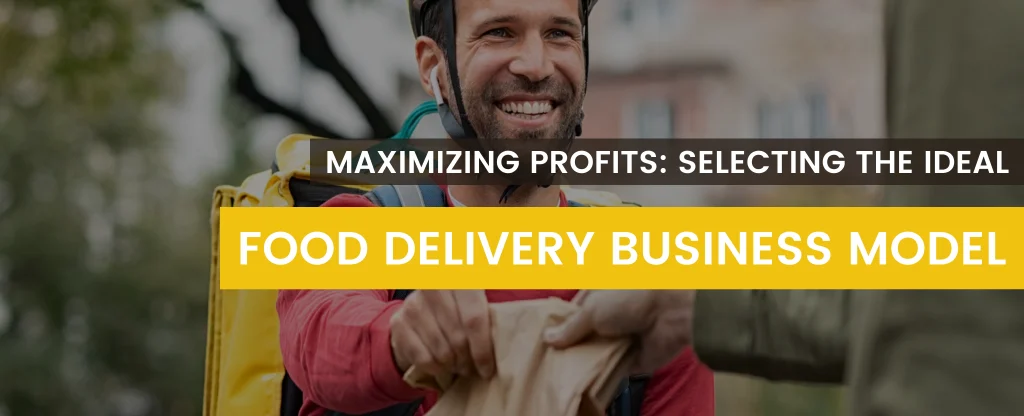
The food delivery business model is expanding dramatically. It’s more common among individuals to place online food orders while relaxing in their homes. And as a result, food delivery app development companies have boomed.
The food industry is a sustainable business that will persist as long as there are people on the planet. In a time of need, you can launch a profitable online food delivery app business with an ideal company strategy.
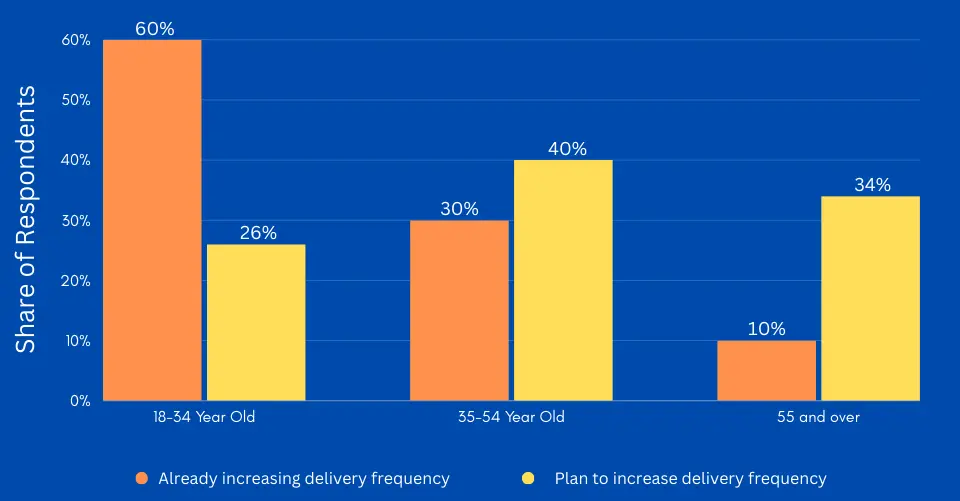
Let’s look at some statistics on the food delivery app market!
You can now order your preferred burger from a selection of nearby restaurants and have it delivered right to your door through various food delivery apps. This shows that food delivery apps need a mobile app development company.
With just one click on their smartphones, consumers can now order from an extensive selection of food outlets due to the availability of online food delivery platforms, which offer fantastic offers and savings. As a result, the food delivery industry is rapidly expanding throughout Asia, Europe, the Middle East, and America.
Food Delivery App Development Statistics
- The worldwide market for online food delivery services is expected to increase at a rate of 3.61% from 2020 USD 111.32 billion, based on the Online Food Delivery Services Global Market Report 2020–30.
- Nevertheless, unanticipated health problems caused a global slowdown in growth in 2020.
- With a compound annual growth rate (CAGR) of 11.51%, the overall market is predicted to reach USD 154.34 billion in 2023.
- At least two times weekly, sixty per cent of American customers place online food orders.
- To watch TV shows and movies at home, 57% of young adults desire food delivered.
- The online food delivery market is anticipated to generate US$231.30 billion in revenue by 2023.
- Sixty percent of restaurants accept that increased sales have come from online ordering and delivery.
- The average yearly rate is rising by 20% due to delivery sales.
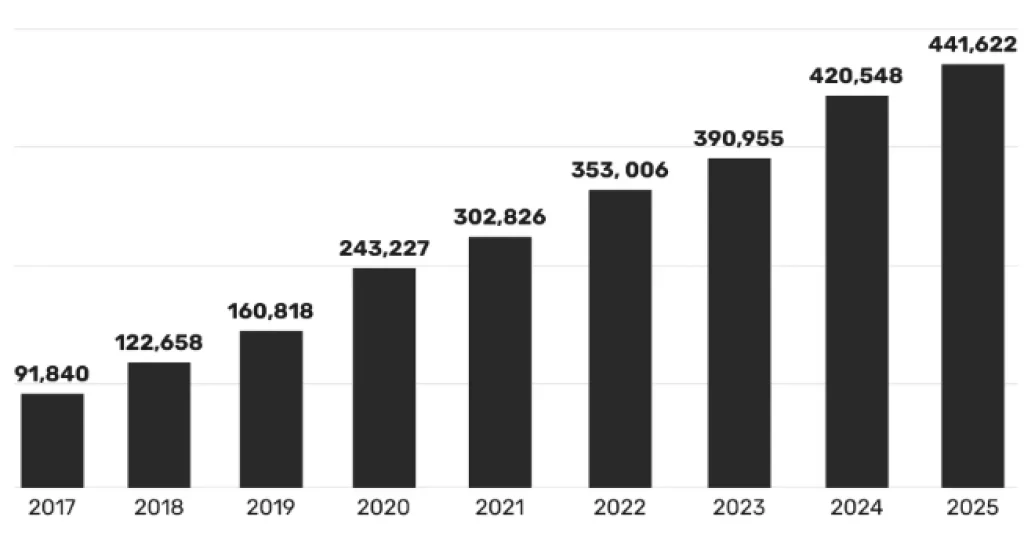
Why Choose the Right Food Delivery Model?
The target clientele determines a food delivery model’s ability to succeed. Additionally, consumers today have a solid drive to use online resources that are user-friendly and convenient. The world’s food delivery market is expected to be worth $182.3 billion by 2024, so picking the appropriate business plan is essential to success.
With the vast digital transformation in this era, businesses must be competitive from all angles. It will be complicated to create a successful product, though. The entire atmosphere is fierce due to the intense rivalry. As a result, operating costs may also increase since increased fuel is needed for your marketing campaigns to achieve greater outreach.
The foundation of any enterprise is its business model, and food delivery is no exception. For this reason, the most profitable food delivery business models will be covered in this guide.
- The overall value of DoorDash is $13 billion.
- UberEats is worth an incredible $20 billion in total.
- Finally, Postmates, estimated at $1.85 billion, became a member of the billion-dollar club.
The appropriate model is essential for running a profitable food delivery app business.
Continue reading to learn about the best business models.
Types of Food Delivery Business Model
In general, three different food delivery models are available in the marketplace. Let’s examine each one of these individually. But remember that most online restaurants that deliver food use a market business model.
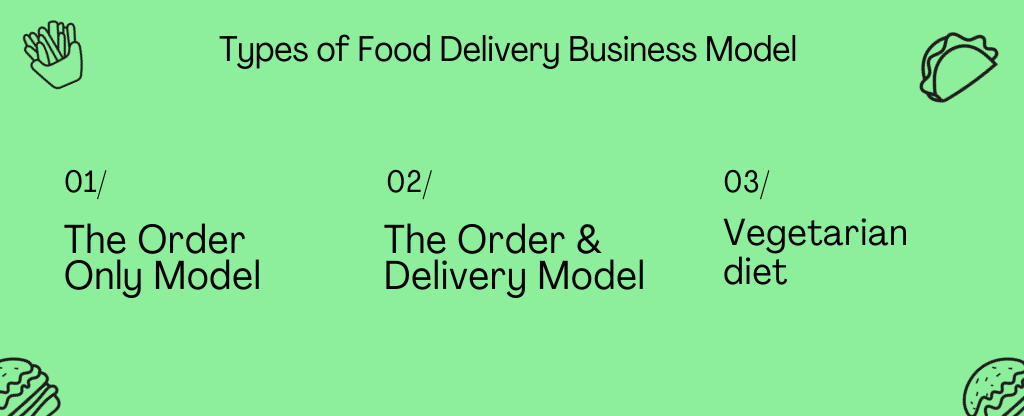
1. The Order Only Model
Grubhub, JustEast, and other companies use this food delivery business plan. Via your internet platform, you will be an intermediary between customers and nearby restaurants in these food delivery business ideas. You’ll make it easier for customers and restaurants to communicate so that orders can be placed and fulfilled.
The primary goal of developing the best online food delivery business model is to make it easier for restaurants to connect with a broader demographic. Conversely, make it simple for consumers to place meal orders from their preferred restaurant.
This food app business model operates in two phases, as follows:.
Order Allocations
- Users may place an order via the applications or website.
- The order will be sent to the restaurants via fax, mail, or smartphone notification.
- They will inform consumers and verify the order.
- Occasionally, the POS system is used for printing the orders straight into the kitchen.
Delivery
- A restaurant delivery boy delivers it to the consumer’s door.
- The delivery boy is given the customer’s mobile number in case there are any problems.
Advantages of Order Only Food Delivery App Model
As an owner, you aren’t confronted with any delivery-related problems when using this kind of business model for food delivery services. You may charge a restaurant a flat commission fee for each submitted order.
1. Challenges of Order Only Food Delivery App Model
Initially, getting restaurants on your platform could be difficult with this delivery business opportunity. As a result, you should investigate the specifics of what you should provide restaurants. To make your business profitable, putting more effort into advertising on your digital platform is necessary. The truth is that the features and amenities that restaurants provide their consumers significantly impact their performance when using this food delivery model.
2. The Order & Delivery Model
This food delivery app business model can simultaneously manage all the food outlets, consumers, and delivery processes. It is among the most widely utilized marketplace options by companies. Since they aren’t concerned about deliveries, most restaurants will sign up with these food delivery platforms.
For this model, some of the most widely used food delivery apps are UberEats, DoorDash, Zomato, etc. This also illustrates that the food delivery business needs a delivery app for its success. Compared to the previous one, additional resources are required to run this kind of food delivery business.
This food app business model operates in two phases, as follows:
Order Allocations
- Restaurants may sign up on your web portal.
- Using your platform, consumers may submit restaurant orders.
- The restaurant receives orders via alerts on its website or app.
- Users have the option of making payments online or with cash on delivery.
Delivery
- The delivery boy closest to the restaurant will be notified when the order is ready to be picked up and delivered to the customer’s location.
- Consumers will be charged delivery costs according to the distance.
- Additionally, consumers can include delivery instructions, such as placing the product outside or not ringing the doorbell.
Advantages of the Order & Delivery Model
Your ability to succeed with this food delivery business model will depend on how customers feel about the restaurants and delivery personnel. Each order can have a flat commission charged to the restaurant. If the order is for less than the specified amount or is delivered further away from where the customer lives, you may additionally charge the consumer for delivery.
You can offer consumers a customized and rapid delivery service by training delivery boys. This will assist you in obtaining higher reviews for your food delivery service. At this point, all that’s required of you is to monitor the activity surrounding your company and address any problems that may be discovered.
Challenges of Order & Delivery Model
The most significant logistical challenge in food delivery is getting the order delivered on time. Most consumers care about delivery times, so you must find out how to provide timely food. Additionally, the order delivery time is significant because of the working hours, particularly for lunch orders. Managing every resource in your company presents another difficulty in this situation.
3. The Fully Integrated Model
In contrast to the first two food delivery models, the third centers on food delivery companies. This template offers a comprehensive business plan for starting your food delivery service. Eat Purely, Extra Plate, RocketFood, and other food delivery companies are examples of this type of business.
As the owner, you should handle everything in this case, from cooking to delivery. You have the option of hiring a chef or cooking the meal yourself. Typically, this kind of prepared food service collaborates with the chefs. A fully integrated model operates as follows:
The two phases of this food delivery app business model are as follows:
Order Allocations
- The initial step involves no administrative work at all; the closest driver will be informed of the order right away.
- Regarding the second, the administrator is partially involved in the distribution of orders.
- The consumer places the order and is routed to the admin panel, which assigns it to the driver who is closest to them.
Delivery
- Here, drivers that are employed by an entity deliver the food.
- A set of food is delivered to each customer’s doorstep by the delivery boy.
- Depending on the needs of the consumer, there may be a quick delivery or a prearranged one.
Advantages of Fully Integrated Model
The primary benefit is not having to depend on another company for customer service. Like these kinds of food delivery startups, your business runs everything. Your company can grow, and you can make much money if everything in your food delivery business strategy works out.
Challenges of a Fully Integrated Model
This food delivery business model’s largest obstacle is its operating expense. Operational expenses have forced many food delivery startups to close their doors. This occurred particularly with those who attempted to prepare their food.
Trying to make numerous deliveries at once and improving user interaction is one way to prevent the business from failing in this way.
Which Food Delivery Business Model To Choose?
Creating an online food delivery app will benefit you now and in the future.
Meanwhile, businesses interested in less traditional setups, such as a meal prep business, can explore this evolving trend that offers different operational methods and funding strategies. These businesses are rapidly becoming popular as an efficient and cost-effective startegy for health-conscious consumers.
Consider developing a food delivery app that offers users a simple and intuitive way to navigate. As a result, you must adhere to all the requirements of the on-demand food delivery app and adopt the concepts of some of the best food delivery apps available. When selecting the right mobile app development company to work on your food delivery business, look for ones with prior experience.
Any one of these three food delivery business models can be chosen to suit your needs. Each of the three business models for food delivery services has advantages and disadvantages. Thoroughly analyze your options and select the one that best fits your food delivery company. We can assist you further if you seek advice on launching a food delivery service. But you must collaborate with a mobile app development company with a successful track record.
This will give your app a smooth user interface and an optimal user experience (UX), improving usability and enabling you to leverage your favorite food delivery app model. Hence, Mindster has the best and most passionate UI/UX design team entrusted to provide the most effective and successful mobile app solutions. You can start an online food business with the best solutions from our experts. Let’s connect now!
- Agentic AI1
- Android Development3
- Artificial Intelligence35
- Classified App3
- Custom App Development5
- Digital Transformation12
- Doctor Appointment Booking App14
- Dropshipping1
- Ecommerce Apps40
- Education Apps2
- Fintech-Apps37
- Fitness App4
- Flutter4
- Flutter Apps20
- Food Delivery App5
- Grocery App Development1
- Grocery Apps3
- Health Care10
- IoT2
- Loyalty Programs9
- Matrimony Apps1
- Microsoft1
- Mobile App Maintenance2
- Mobile Apps130
- Product Engineering6
- Progressive Web Apps1
- React Native Apps2
- Saas Application2
- Shopify9
- Software Development3
- Taxi Booking Apps7
- Truck Booking App5
- UI UX Design8
- Uncategorized6
- Web App Development1









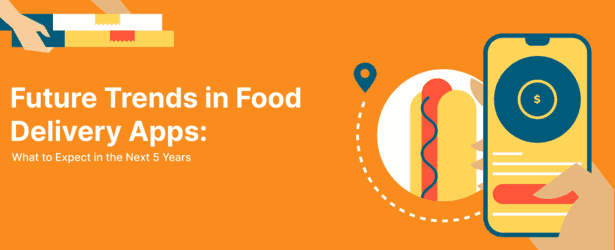
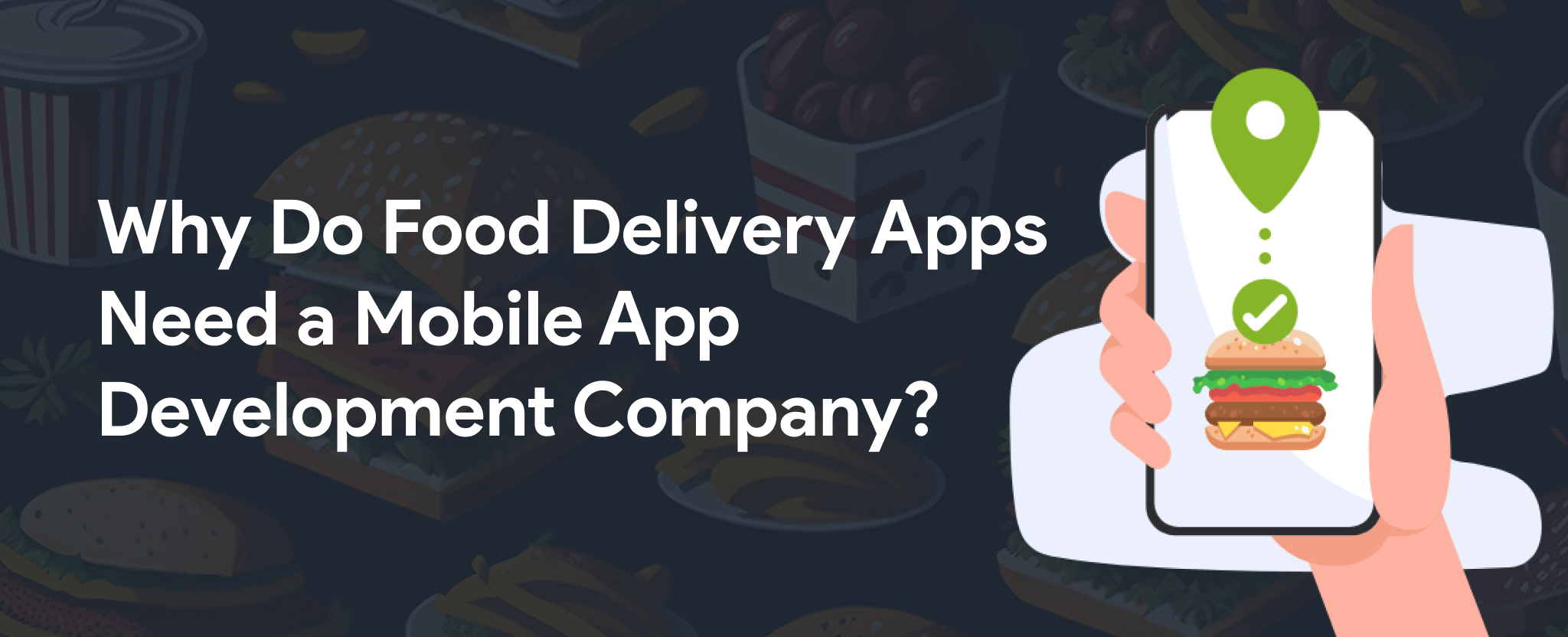
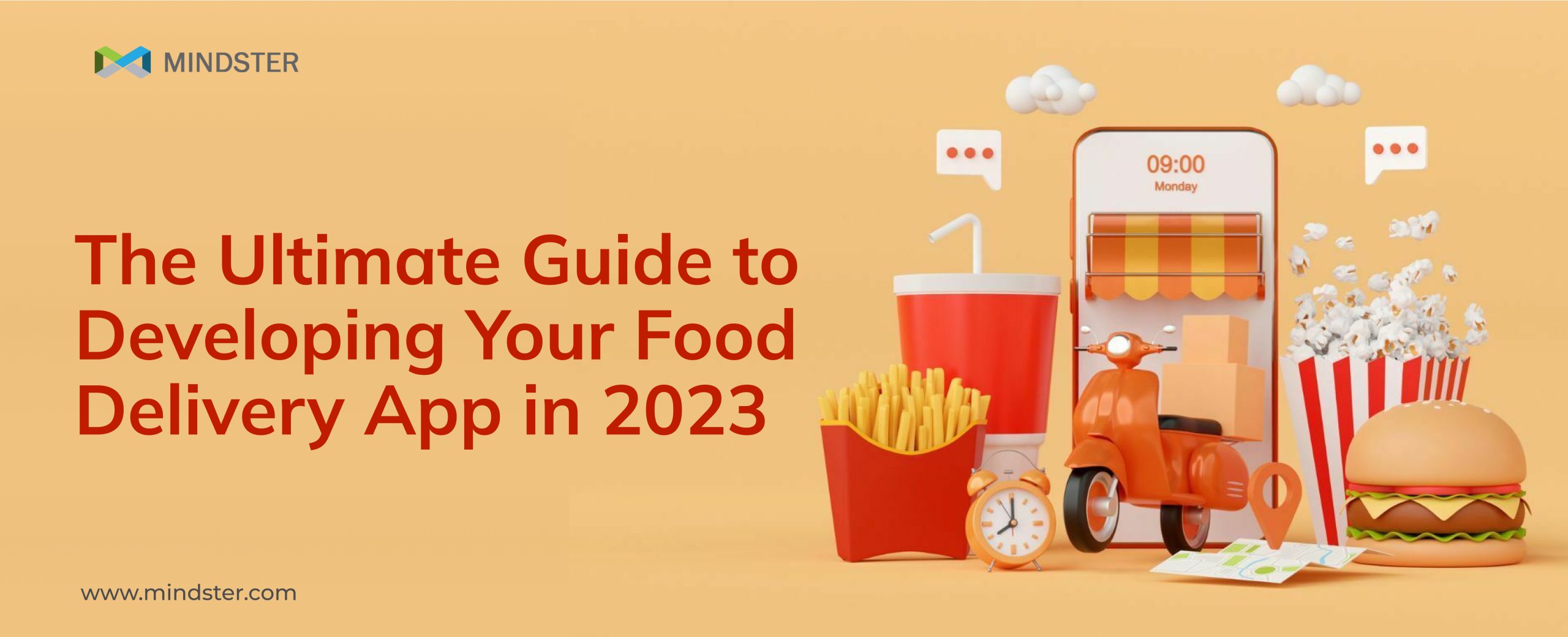
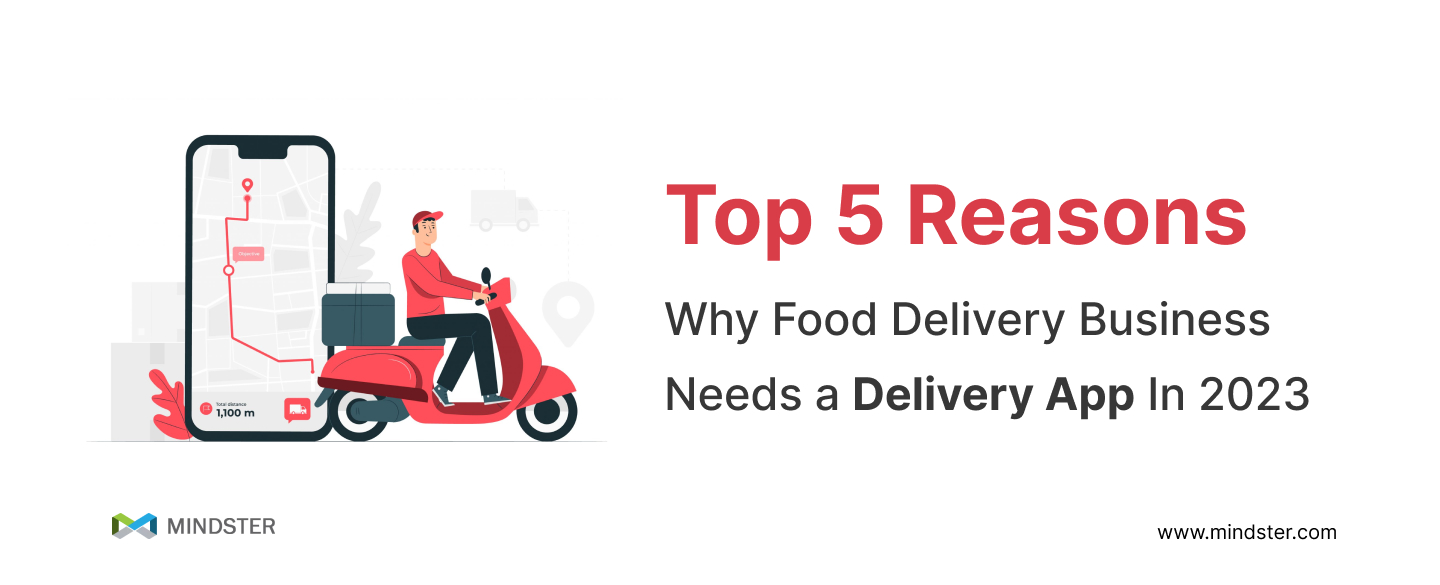






Comments